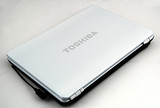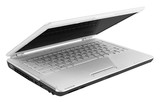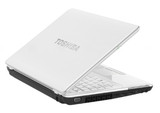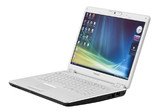Toshiba Portégé M800
Especificaciones de Portátil(es)
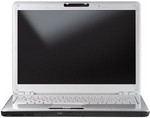
Pricecompare
Promedio de 10 puntuaciones (de 13 análisis)
Análisis para el Toshiba Portégé M800
Origen: PC Authority
 EN→ES Archive.org version
EN→ES Archive.org versionBut the Toshiba’s greatest problem is the competition. With the likes of Lenovo ThinkPad X200 proving cheaper and better in almost every regard, it just doesn’t do enough.
Preis schlecht
Único Análisis, disponible online, corto, Fecha: 01/12/2009
Puntuación: precio: 40%
Origen: Pocket Lint
 EN→ES Archive.org version
EN→ES Archive.org versionThe Toshiba Portege M800 is a great machine to use every day. Surprisingly, Toshiba hasn’t charged a premium for this machine and at £780 (inc. VAT) is one of the best multimedia notebooks we’ve seen in recent months.
8 von 10, Verarbeitung gut, Leistung gut
Único Análisis, disponible online, Muy corto, Fecha: 10/01/2008
Puntuación: Puntuación total: 80% rendimiento: 80% procesamiento: 80%
Origen: Trusted Reviews
 EN→ES Archive.org version
EN→ES Archive.org versionWith the Portégé M800-106, Toshiba delivers a 13.3in notebook that's attractive enough, eminently portable and stuffed with features. It also continues Toshiba's reputation for excellent notebook speakers. However, it's let down by an average screen and incredibly poor battery life, meaning that if you want to use it on the move you'll have to spend close to £100 more to get the desired performance. This, ultimately, makes the M800 disappointing value for money despite its other potential strengths, so Toshiba should be kicking itself for its penny-pinching since it makes an otherwise good notebook rather ordinary.
(von 10): 6, Preis 6, Leistung 6, Ausstattung 9
Único Análisis, disponible online, largo, Fecha: 09/12/2008
Puntuación: Puntuación total: 60% precio: 60% rendimiento: 60% características: 90%
Origen: Star Techcentral
 EN→ES Archive.org version
EN→ES Archive.org versionOverall, the Toshiba M800 is a winner in terms of looks and design. The white and glossy finish is just too attractive to dismiss and while I was out and about over the weekend, I spotted a pastel pink M800 and thought that was equally riveting — in a girly way. White, however, is the new pink and is neutral and non-gender specific. That said, the M800 is great for those in need of a stylish notebook that exudes an air of professionalism.
Mobilität gut
Único Análisis, disponible online, corto, Fecha: 09/03/2008
Puntuación: movilidad: 80%
Origen: Techradar
 EN→ES Archive.org version
EN→ES Archive.org versionThe Toshiba Portégé M800-106 is a highly appealing laptop that manages to blend style and performance in one easy to use package. Those looking for a powerhouse machine they can carry around on a regular basis will be impressed with what it has to offer.
4 von 5, Verarbeitung gut, Display gut, Leistung gut
Único Análisis, disponible online, corto, Fecha: 09/02/2008
Puntuación: Puntuación total: 80% rendimiento: 80% pantalla: 80% procesamiento: 80%
Origen: PC Pro
 EN→ES Archive.org version
EN→ES Archive.org versionFor a long time it was only Apple's laptops that came in white, but now they're ten-a-penny. Even the sub-£200 Eee PC and its gang of low-cost netbooks are clad in white these days. But despite lacking the exclusivity that it once brought, the finish looks stylish on Toshiba's latest laptop. A nod to Apple's iconic design from Toshiba, but perhaps the original is best.
4 von 6
Único Análisis, disponible online, Mediano, Fecha: 08/01/2008
Puntuación: Puntuación total: 67%
Origen: Hardware Zone
 EN→ES Archive.org version
EN→ES Archive.org versionWhile the performance of the Toshiba Portege M800 wasn't anything mind blowing, it makes up for this by delivering a smooth multimedia experience that should please the senses. The built-in FM radio reception worked surprisingly well and before you dismiss it as a gimmicky snag, at least the tuner does provide some entertainment on the go without stressing the battery excessively. Audio playback was also adequate, and was capable of clear and crisp audio results. Just don't except any hard-hitting bass from the tiny speakers. The M800 does have its fair share of concerns, though these are mostly minor that can be easily overlooked. For example, the screen was glassy, vibrant and clear dead-on, but suffered from mild color shifts and a washout when our eyes strayed off the vertical axis slightly. If you think about it positively though, that means you're ensured some privacy when viewing your screen. So like we mentioned earlier, there's nothing really glaring to be concerned on the M800. Retailing at a cool S$2299, the Toshiba Portege M800 will not burn that big a hole in your pocket unlike some of the other 13.3-inch ultraportable notebooks, so why not test-drive the M800 if you're looking for a stylish rig that delivers a pretty decent overall experience?
4 von 5, Leistung mäßig
Único Análisis, disponible online, Mediano, Fecha: 06/19/2008
Puntuación: Puntuación total: 80% rendimiento: 60%
Origen: PC Welt
 DE→ES Archive.org version
DE→ES Archive.org versionÚnico Análisis, disponible online, Mediano, Fecha: 05/11/2009
Puntuación: Puntuación total: 67% precio: 80% rendimiento: 67% características: 37% movilidad: 80% ergonomía: 51%
Origen: Notebookjournal
 DE→ES Archive.org version
DE→ES Archive.org versionÚnico Análisis, disponible online, largo, Fecha: 03/27/2009
Puntuación: Puntuación total: 90% precio: 80% rendimiento: 70% características: 50% pantalla: 40% movilidad: 60% procesamiento: 50% ergonomía: 70%
Origen: PC Praxis - 4/09

Comparación, , Longitud Desconocida, Fecha: 03/01/2009
Puntuación: Puntuación total: 90% precio: 70%
Origen: c't - 2/09

Comparación, , largo, Fecha: 01/01/2009
Puntuación: rendimiento: 70% características: 70% pantalla: 40% movilidad: 70% ergonomía: 80% emisiones: 80%
Origen: PC Go - 10/08

Único Análisis, , Longitud Desconocida, Fecha: 10/01/2008
Puntuación: Puntuación total: 71% precio: 80% procesamiento: 80%
Origen: NotebookTV.hu
 HU→ES Archive.org version
HU→ES Archive.org versionÚnico Análisis, disponible online, Mediano, Fecha: 06/20/2009
Puntuación: Puntuación total: 80% precio: 60% rendimiento: 70% pantalla: 90% movilidad: 90% procesamiento: 80% ergonomía: 100% emisiones: 100%
Comentario
Intel Graphics Media Accelerator (GMA) X3100: Intel Graphics Media Accelerator (GMA) X3100 es un chip de video integrado (incorporado) en un chipset de Mobile Intel 965GM (para Merom =Core 2 arquitectura). Es el sucesor del Intel GMA 950. Lo más interesante es la integración de un pipeline completamente programable. Debido a la integración de características Direct X9, HDR y Hardware Transform & Lighning (T&L) – su predecesor solo tenía Software T&L – debería estar listo para Windows Vista Premium (soporte Aero Glass completamente). Con respecto a los datos, el rendimiento debe ser claramente mejor al de GMA 950.
Muchos juegos son difícilmente ejecutables con estos adaptadores gráficos o se ejecutan de manera muy lenta.
>> Más información puede ser encontrada en nuestra comparación de tarjetas gráficas moviles y la lista de benchmarks.
Intel Core 2 Duo: Este es el sucesor Core Duo y el Core Solo con un pipeline más largo y con una velocidad entre 5-20% sin mayor consumo de energía. Adicional al diseño de Core Duo existe un cuarto decodificador, una unidad SSE ampliada y una unidad lógica aritmética (ALU) adicional.
Sus características son: 2 núcleos (cores), una amplificación de comando de 64-bit EM64T y 2 o 4 MB L2 Cache y 291 millones de transistores, que son acabados en 65nm. Mas allá de esto, todos los tipos soportan técnicas "Execute Disable Bit", SSSE3 (SSE4), Enhanced Speedstep, LaGrande y la mayoría de técnicas de virtualizacion (VT) Vanderpool.
El Core 2 Duo para laptops es idéntico a los procesadores Core 2 Duo para desktops, pero los procesadores para notebooks trabajan con tensiones más bajas (0.95 a 1188 Volt) y un Frontside bus clock (1066 contra 667 MHz). El rendimiento de laptops cuena con una frecuencia de 20-25% más baja que PCs Desktop debido a una frecuencia más baja de Frontside bus y los discos duros más lentos.
T5750: Procesador dual core de nivel básico basado en el núcleo Merom sin soporte para Virtualization y una temperatura máxima baja.
>> Más información puede ser encontrada en nuestra comparación de procesadores móviles.
13.30": Sobretodo, este tamaño de pantalla es usado para subportátiles, ultrabooks y convertibles. Para los tres tipos, este tamaño es bastante grande. La mayor variedad de subportátiles es representada con este tamaño.
Grandes tamaños de pantalla permiten resoluciones más altas. Por tanto, los detalles como letras son más grandes. Por otro lado, el consumo de energía es más bajo con diagonales de pantalla más pequeñas y los aparatos son más pequeños, más livianos y más económicos.
>> Para averiguar cual fina es una pantalla, vea nuestra lista de DPI.
1.9 kg: Normalmente subportátiles, ultrabooks y portátiles muy livianos con diagonales de pantalla de 12-16 pulgadas pesan así.
Toshiba: Toshiba Corporation es un conglomerado o grupo tecnológico japonés. La empresa se fundó en 1939 y en 1978 Toshiba se convirtió en el nombre oficial de la empresa. Los productos y servicios de la empresa incluyen sistemas de energía, infraestructuras industriales y sociales, ascensores y escaleras mecánicas, componentes electrónicos, semiconductores, discos duros, impresoras, baterías, iluminación, logística y tecnología de la información. Toshiba era uno de los mayores fabricantes de ordenadores personales, electrónica de consumo, electrodomésticos y equipos médicos.
76.5%: Esta evaluación no es convincente. Debe ser considerado que difícilmente existen portátiles que reciben una evaluación abajo de 60%. Esta portátil es evaluada abajo del promedio, esta realmente no es una recomendación para la compra.
>> Más información puede ser encontrada en nuestra Guia de compra de portátiles.


 Deutsch
Deutsch English
English Español
Español Français
Français Italiano
Italiano Nederlands
Nederlands Polski
Polski Português
Português Русский
Русский Türkçe
Türkçe Svenska
Svenska Chinese
Chinese Magyar
Magyar